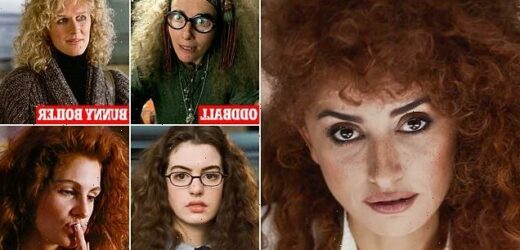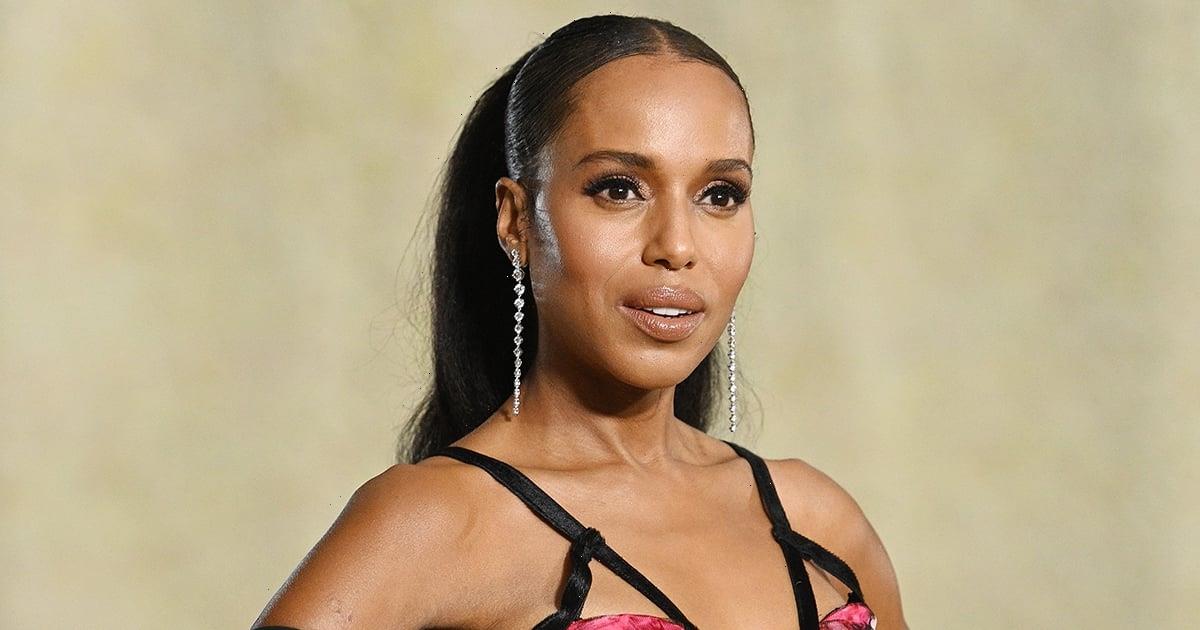Why are girls with curls on screen always WEIRD or WICKED? From Emma Thompson’s mad grey mop to Anne Hathaway’s cascade of dull frizz, ringlets have become shorthand for being wild, disorganised or unprofessional
- Hollywood believes natural curls can’t be beautiful or aspirational, hence no leading lady ever has them, according the Hilary Freeman
- The UK-based journalist details curly haired characters in an array of films
- From Anne Hathaway’s quirky the Princess Diaries to Glenn Closes’ mane
By anyone’s standards, actress Penelope Cruz is a sultry beauty. So when the directors of her latest film, the critically acclaimed satire Official Competition, wanted her to portray an eccentric, power crazed woman, they gave her a brand new hairdo.
In place of her usual long, dark, sleek locks, she sports a huge, bright red, clown-like mess of frizzy curls. How predictable. As a naturally curly haired woman, with an even more curly-haired daughter, I’m fed up with the negative image so often reflected back at me through the silver screen. Whenever a movie wants to show that a woman is mad, bad or dangerous to know, it gives her character frizzy, curly hair…like mine.
In thrillers, curls are the preserve of the villainess who will inevitably meet a well-deserved, sticky end. Perhaps the most iconic example of this is Fatal Attraction’s unhinged stalker and rabbit killer, Glenn Close, whose Medusa-like spirals signified her lustful obsessions.
Hollywood believes natural curls can’t be beautiful or aspirational, hence no leading lady ever has them, according the Hilary Freeman. Wild: Penelope Cruz was given a huge head of red curls for new movie Official Competition
All three of The Witches of Eastwick had untamed curly hair which grew bigger and more unruly as they became more powerful and hedonistic. And when Emma Thompson wore a frizzy wig in the Harry Potter films, it was to highlight just how eccentric her fortune-telling professor character, Sybill Trelawney, was.
Having big curls has also become big (and small) screen shorthand for being wild, disorganised or unprofessional, not to mention kooky, klutzy, or just plain weird, like Cameron Diaz in Being John Malkovich. And plain is the operative word. Hollywood believes natural curls can’t be beautiful or aspirational, hence no leading lady ever has them.
Emma Thompson as Professor Sybil Trelawney in Harry Potter and The Prisoner of Azkaban. Emma wore a frizzy wig in the Harry Potter films, it was to highlight just how eccentric her fortune-telling professor character was
If the star does possess curls, you can be darn sure they’ll be smoothed into oblivion before she’s allowed to kiss her leading man. (Male leads are allowed to have ruffled curls, of course, because that’s sexy.) This leads me to the most popular curly trope of all: the lost soul in need of a life makeover, whose true beauty is hiding underneath that horrible halo of frizz, if only she, and we, could see it. It’s Pygmalion, with styling tools. To name just a few, there’s Sandra Bullock in Miss Congeniality, Anne Hathaway in the Princess Diaries, and Julia Roberts in Pretty Woman, who has loose ringlets to match her supposedly loose morals, until she falls for Richard Gere, gives up prostitution, and gets a sleek new hairdo alongside a new wardrobe.
This phenomenon is so ubiquitous that it would be almost laughable, if there weren’t some rather unsavoury, even, dare I say, racist undertones to it. The idea that your physical features can convey anything about your character is both outdated and offensive. While the Victorians may have believed in the pseudo-science of physiognomy — for example, that a high brow denotes intelligence, or a hawk-like nose, criminality —we now dismiss such theories as lazy stereotypes with no basis in fact. Except, it seems, when it comes to frizzy hair.
Curly hair is far more common in women from ethnic backgrounds — black, Latino or, like me, Jewish. Among my community, my type of hair is often referred to as a ‘Jewfro’. Without copious amounts of styling products on my candy-floss-like mop, I resemble Art Garfunkel, or, worse, Phil Spector.
Perhaps the most iconic example of this is Fatal Attraction’s unhinged stalker and rabbit killer, Glenn Close, whose Medusa-like spirals signified her lustful obsessions
Despite the number of Jewish actresses in Hollywood, it’s only the ones who don’t appear to be so — like Lauren Bacall, or Scarlett Johansson — who get starring roles. Those who look more obviously or stereotypically Jewish (aside from Barbra Streisand — the exception to almost every rule) only get to play kooky characters.
And young actress Zendaya, who is of mixed race, and for years straightened her hair, says: ‘Growing up, I wasn’t very confident in my curls. It wasn’t like the hair that girls around me had. And nobody really knew what to do with my hair.’
Julia Roberts in Pretty Woman, who has loose ringlets are meant to match her supposedly loose morals, until she falls for Richard Gere, gives up prostitution, and gets a sleek new hairdo alongside a new wardrobe
As a child I hated my curls, which I felt set me apart and made me look unattractive. At 12, my mother finally agreed to let me have my hair chemically-straightened. The foul-smelling treatment didn’t work, serving only to make it more frizzy. Since then, I have decided to embrace my hair, refusing to bow to pressure to straighten it.
Most people are complimentary; I’ve been told my curls make me look more youthful, more creative, and more bohemian. But there have also been the negative ‘you look unprofessional’ comments. Once, I decided not to pursue a job in an office where I was told I’d have to tie my hair back. Another friend reports her hairdresser advising she straighten her hair in order to look ‘like a grown-up’.
When my daughter Sidonie, now seven, learnt to read, I bought her a book about a little girl who hates and then learns to love her curls, in the hope she would embrace her own beautiful ringlets.
Anne Hathaway’s frizzy mop in The Princess Diaries is meant to signal the character’s wild, disorganised and clumsy nature
So far it’s worked, although I’m sure she’ll reach for the straighteners when she’s a teenager. While curly-haired Merida from the Disney animated film Brave has been a helpful role model, Sidonie prefers the princesses with conventional blonde, mermaid waves.
If only there were more examples of strong, well-adjusted and beautiful curly-haired women on screen for her.
Source: Read Full Article






